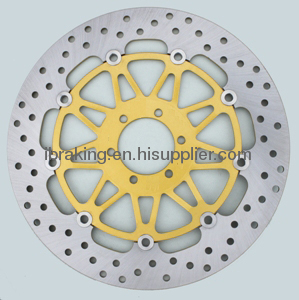
|
Ningbo Imake Industry & Trade co.,LTD
|
YAMAHA RACING BRAKE DISCS
| Payment Terms: | T/T,L/C |
| Special Groups: |
1000cc to 1499cc (11)
|
| Place of Origin: | Zhejiang, China (Mainland) |
|
|
|
| Add to My Favorites | |
| HiSupplier Escrow |
Product Detail
1987 YAMAHA FZR1000 is a very well-balanced bike with massive amounts of power
Product Name:1000CC YAMAHA RACING BRAKE ROTORS
Histroy:

The FZR1000 Genesis is a milestone model as it marked the transition from 2 strokes to 4 stroke super sport motorcycles. This shift represented a new generation of high performance big bikes, which employed Yamaha racing technology from the track.
Histroy:
The bike that brought Yamaha to the forefront of super bike design was launched in 1987 and it was called FZR1000. The 1987 version of the Yamaha FZR1000 had a top speed of over 250km/h and the 1989 version, crowned "The bike of the Decade", could accelerate from 0-60 in less than 3 seconds and it also had a top speed of over 270km/h. With these features any bike would be very appreciated, so production continued.
Yamaha improved the performance of the bike, notably in 1989 when the engine was enlarged to 1002cc and added an electronically operated exhaust valve whose acronym led to the bike being universally known as the EXUP.
In spite of higher displacement its size was 8mm shorter and more compact, due to a revised inclination angle of the cylinders to 35 degrees. Valve angles and sizes had been changed, as well as the camshaft timing. Bigger carburetors helped boost performance and the crankshaft has been strengthened, alog with countless other modifications.
The system added useful mid range performance and the engine's power was also increased to 145bhp.
The unique feature which gave the 1989 onward models their "EXUP" name was a servo motor driven exhaust valve. This allowed large bore exhaust reader pipes (for excellent gas flow at high engine speeds) coupled with the valve restricting flow at lower revs, to speed the gas through.
The chassis was also improved and the bike handled better, making the EXUP the pick of the Japanese Super bikes.
The 1989 frame (now called Delta box 2) used the engine as a stressed member. Gone were the down tubes, replaced by a sturdy fixation of the cylinder head with the frames upper box section. This layout was the foundation for the radical YZF-R1 chassis layout almost 10 years later.
But improving didn't stop there. In 1991 the package was further improved with the FZR1000RU, featuring sharper and upside-down forks.
The last model improvements were in 1991 and 1994, until the FZR1000 was replaced by the YZF 1000 Thunder Ace in 1996.

The FZR1000 Genesis is a milestone model as it marked the transition from 2 strokes to 4 stroke super sport motorcycles. This shift represented a new generation of high performance big bikes, which employed Yamaha racing technology from the track.
The first FZR1000 Genesis, presented to the public at the Cologne IFMA motorcycle show in Germany on September 18, 1986 continued the success of it's supersport predecessors, the RD 350 and RD 500.
The FZR1000 is a very well-balanced bike with massive amounts of power. The chassis is perfectly capable of maintaining its composure under the stress of a motor at full throttle, and this makes the ride and the feel of the bike more enjoyable.
One of my favorite things about this machine is its extreme light weight and maneuverability. Due to its layout with 45 degree angled cylinders and relatively low seat height it feels lighter than a brand new R1, although it's about 50 pounds heavier. The bike is very easy to handle around town and it has a very satisfying acceleration.
When you ride the FZR1000 you feel like you are a part of the machine and the ride is more enjoyable. On the modern sport bikes you are perched on top of the bike and the ride is not so comfortable.
But what goes fast, needs to stop fast and the FZR1000 has no problem with powerful braking. The bike's solid and reliable breaking system will do the job for you every single time.
The bike's powerful engine really starts to scream when you hit 7000 RPM and no moving object on the road will leave you behind at full throttle.
The 20-valve inline four built by Yamaha is one of the most reliable power plants ever constructed so you will ride the bike with no worry.
Didn't find what you're looking for?
Post Buying Lead or contact
HiSupplier Customer Service Center
for help!










